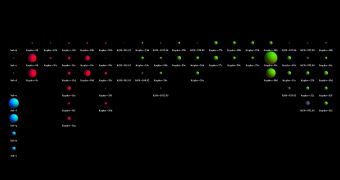Officials at the American space agency announce the discovery of a new series of extrasolar planets, this time organized in a number of star systems. Instances where multiple planets spin around the same star – such as is the case with the solar system – are not that common, apparently.
In fact, the new discovery tripled the number of star systems known to have multiple planets in their orbits. At the same time, the data raise the number of verified exoplanets detected by the NASA Kepler Telescope by nearly 100 percent.
Studying multi-planetary systems is very important because this could reveal how planets form around their parent stars. Such an analysis would also have implications on our understanding of how our own solar system formed.
What was interesting to exoplanetary researchers from the get-go was the fact that not many star systems featuring multiple planets have the tendency to exhibit a setup similar to the one present around the Sun – several rocky worlds preceded by gas giants, and interceded by dwarf planets.
Still, Kepler is continuing its search for the perfect Earth-analog. Thus far, it managed to identify more than 3,200 exoplanetary candidates – alien planets that have yet to be confirmed by other telescopes – and experts estimate that more than 80 percent of those entries are correct results.
In the new batch, astronomers propose that the sizes of planets range from 1.5 times that of Earth to higher than the mass of Jupiter, the largest planet in the solar system. Of the 26 planets, 15 are larger than Earth, but smaller than Neptune.
However, establishing precisely which is which is going to take a long time. Astronomers say that subsequent observations by ground-based telescopes will eventually determine which worlds are rocky, and which of them are surrounded by thick, gaseous atmosphere.
Interestingly, all the exoplanets in the study are closer to their parent stars than Venus is to our Sun. The latter needs 224.7 Earth days to complete an orbit around the star, whereas the new exoplanets require between 6 and 143 days to do the same.
“Prior to the Kepler mission, we knew of perhaps 500 exoplanets across the whole sky. Now, in just two years staring at a patch of sky not much bigger than your fist, Kepler has discovered more than 60 planets and more than 2,300 planet candidates,” expert Doug Hudgins explains.
“This tells us that our galaxy is positively loaded with planets of all sizes and orbits,” concludes the investigator, who holds an appointment as a Kepler program scientist at NASA Headquarters, in Washington, DC.

 14 DAY TRIAL //
14 DAY TRIAL //